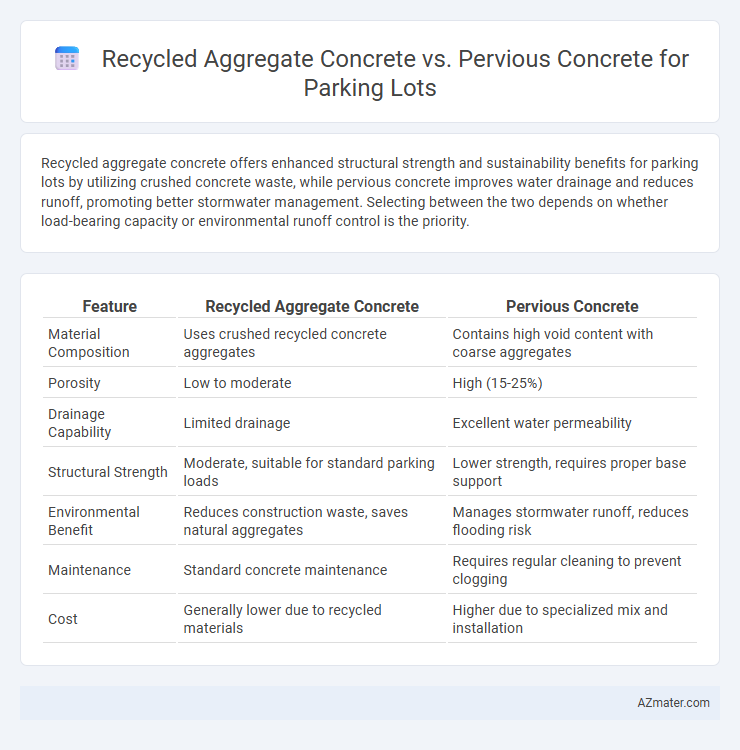Recycled aggregate concrete offers enhanced structural strength and sustainability benefits for parking lots by utilizing crushed concrete waste, while pervious concrete improves water drainage and reduces runoff, promoting better stormwater management. Selecting between the two depends on whether load-bearing capacity or environmental runoff control is the priority.
Table of Comparison
| Feature | Recycled Aggregate Concrete | Pervious Concrete |
|---|---|---|
| Material Composition | Uses crushed recycled concrete aggregates | Contains high void content with coarse aggregates |
| Porosity | Low to moderate | High (15-25%) |
| Drainage Capability | Limited drainage | Excellent water permeability |
| Structural Strength | Moderate, suitable for standard parking loads | Lower strength, requires proper base support |
| Environmental Benefit | Reduces construction waste, saves natural aggregates | Manages stormwater runoff, reduces flooding risk |
| Maintenance | Standard concrete maintenance | Requires regular cleaning to prevent clogging |
| Cost | Generally lower due to recycled materials | Higher due to specialized mix and installation |
Introduction to Sustainable Parking Lot Materials
Recycled aggregate concrete incorporates crushed construction waste, reducing landfill impact while maintaining structural integrity for parking lots. Pervious concrete enhances stormwater management by allowing water infiltration, decreasing runoff and promoting groundwater recharge. Both materials contribute to sustainable parking lot design by improving environmental performance and resource efficiency.
What is Recycled Aggregate Concrete?
Recycled aggregate concrete (RAC) is a sustainable construction material that incorporates crushed concrete debris as a substitute for natural aggregates, significantly reducing environmental impact and resource depletion. It offers comparable strength and durability to conventional concrete, making it suitable for parking lots while promoting waste reduction. RAC supports eco-friendly infrastructure development by minimizing landfill use and conserving natural stone resources without compromising structural integrity.
Understanding Pervious Concrete
Pervious concrete for parking lots offers superior stormwater management by allowing water to infiltrate through its porous structure, reducing runoff and promoting groundwater recharge. Unlike recycled aggregate concrete, which prioritizes sustainability by reusing materials, pervious concrete's open-graded mix design enhances permeability without compromising structural integrity. Its application is crucial in urban environments seeking to mitigate flooding and improve water quality through natural filtration.
Material Composition and Properties Comparison
Recycled aggregate concrete (RAC) for parking lots incorporates crushed concrete and masonry debris, offering enhanced compressive strength and durability by reusing waste materials, while pervious concrete is a blend of cement, coarse aggregates, and water designed for high porosity to enable water infiltration. RAC typically has a lower permeability due to its dense matrix but provides superior load-bearing capacity, making it suitable for heavy traffic areas, whereas pervious concrete's void content ranges from 15% to 25%, promoting stormwater management but limiting its structural strength. The material composition of RAC emphasizes recycled aggregates replacing natural ones, optimizing sustainability without significant performance loss, while pervious concrete focuses on aggregate gradation and minimal fine materials to maintain void spaces essential for permeability.
Environmental Benefits: Recycled vs. Pervious Concrete
Recycled aggregate concrete reduces construction waste by reusing crushed concrete and demolition debris, significantly lowering the demand for virgin materials and minimizing landfill impact. Pervious concrete enhances stormwater management through its high permeability, reducing runoff and promoting groundwater recharge, which helps mitigate urban flooding and improve water quality. Both materials contribute to sustainable parking lot design by decreasing environmental footprint, but recycled aggregate concrete excels in resource conservation, while pervious concrete provides superior water management benefits.
Permeability and Drainage Performance
Pervious concrete offers superior permeability and drainage performance compared to recycled aggregate concrete, allowing water to pass through its interconnected voids and reducing surface runoff effectively. Recycled aggregate concrete, while environmentally beneficial by reusing construction waste, typically exhibits lower permeability due to denser aggregate compaction, which can lead to less efficient drainage and potential water pooling in parking lots. The high porosity of pervious concrete enhances stormwater management by promoting rapid infiltration, making it the preferred choice for permeable parking lot surfaces.
Structural Strength and Durability
Recycled aggregate concrete offers enhanced structural strength and durability for parking lots due to its higher compressive strength and resistance to freeze-thaw cycles compared to pervious concrete. Pervious concrete, while beneficial for stormwater management, typically exhibits lower strength and may experience reduced durability under heavy traffic loads and harsh environmental conditions. Selecting recycled aggregate concrete ensures long-term performance and load-bearing capacity, making it more suitable for high-traffic parking areas.
Installation and Maintenance Considerations
Recycled aggregate concrete offers durability and easier installation in traditional parking lot projects due to its compatibility with standard paving equipment and minimal curing requirements. Pervious concrete requires specialized installation techniques, including careful mixture control and compaction to maintain permeability, which may increase initial costs and complexity. Maintenance for recycled aggregate concrete involves periodic sealing and crack repair, while pervious concrete demands regular vacuuming or pressure washing to prevent clogging and sustain drainage performance.
Cost Analysis: Initial and Long-term Expenses
Recycled aggregate concrete (RAC) typically offers lower initial costs due to the use of reclaimed materials, reducing expenses related to raw aggregates and disposal fees. Pervious concrete, while having higher upfront costs associated with specialized mix design and installation, can lead to long-term savings by mitigating stormwater management fees and reducing the need for costly drainage infrastructure. Over time, RAC may require more maintenance to address durability concerns, whereas pervious concrete's cost efficiency improves through enhanced water infiltration and reduced environmental impact.
Choosing the Best Concrete Solution for Parking Lots
Recycled aggregate concrete offers high compressive strength and durability, making it suitable for parking lots with heavy vehicle loads and frequent traffic. Pervious concrete enhances stormwater management by allowing water to permeate through, reducing runoff and promoting groundwater recharge in parking areas. Choosing between the two depends on project priorities; recycled aggregate concrete excels in structural performance while pervious concrete optimizes environmental sustainability and drainage.

Infographic: Recycled aggregate concrete vs Pervious concrete for Parking Lot
 azmater.com
azmater.com